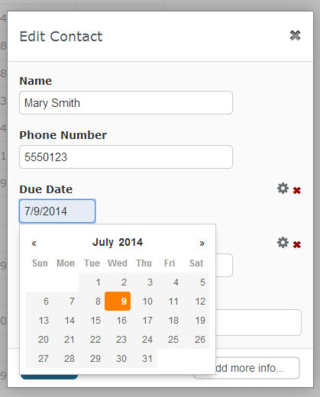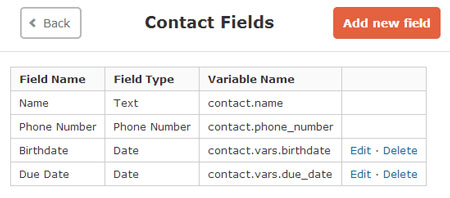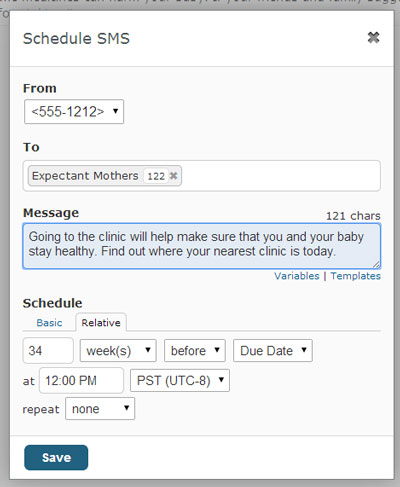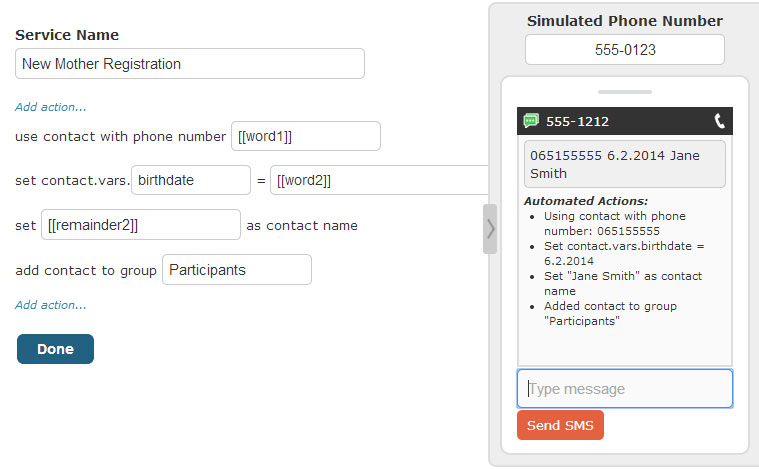At the request of several organizations conducting mHealth projects—including the Mobile Alliance for Maternal Action—we’re excited to unveil new tools that will make Telerivet even more useful for organizations conducting maternal or infant health campaigns, and for many other businesses and NGOs too.
Store important dates as contact information
Telerivet already supports storing custom contact information (e.g. text, numbers, yes/no fields, email addresses, and alternate phone numbers) and with this update, we’ve included dates as a new type of contact information that you can store.
Whether you need to keep track of expectant mothers’ due dates, customer birthdates, or borrowers’ repayment dates, you can now include important date information for contacts in Telerivet. When you store information in a date field, you’ll be able to sort contacts chronologically by date, and quickly input dates using a calendar.
We also made it easier to manage your custom contact information. On the Contacts page, click “More”, then click “Manage fields”. If you’ve already been storing dates as text, you can edit your Text field and change its type to Date.
Schedule messages relative to each contact
Now that you can store dates for each contact, Telerivet also now makes it super simple to schedule messages relative to those dates. For example:
-
Maternal health campaign managers can schedule a series of messages for a particular number of weeks before or after the expectant mother’s due date.
-
Business owners can easily wish their customers a happy birthday by storing their contacts' birthdates and scheduling a message on their birthday every year.
With "relative" scheduled messages, it’s no longer necessary to manually calculate the right time to send each message for each contact. Simply import your contact information and let Telerivet calculate the right time to send each message.
To schedule a relative message, go to the Messages page, click “New Message”, then “Schedule”, then click the “Relative” tab. Everything works the same way as scheduling a basic message to a group or set of contacts, but instead of specifying one date to send all messages, you select an interval relative to one of your Date fields. For example, “34 weeks before Due Date”, “on Due Date”, or “2 months after Due Date”:
When you save a relative message, Telerivet will automatically generate a scheduled message for each contact and will keep the schedule updated even if contact information changes or if new contacts are added or removed.
You can easily see when each message will be sent on the “Scheduled” tab of the Messages page (the auto-generated messages are shown in blue).
Register other contacts via the Rules Engine
Telerivet’s Rules Engine has always made it easy to build systems that let people update their own contact information. Now we’ve made it possible to build systems that let you update a contact different from the one who sent the message.
As shown in the example below, this feature lets community health workers use their own mobile phones to collect due dates from expectant mothers and send a structured SMS message containing the expectant mother’s phone number, due date, and name (eg. “065155555 6.2.14 Jane Smith”). With the simple automated service below, Telerivet will automatically update the contact information and schedule the expectant mother to receive personalized messages according to their due date:
You can customize Telerivet to interpret dates in your local format (such as m/d/yy or d.m.yy), and Telerivet can even interpret dates if the year is omitted.
If someone registers an invalid date, Telerivet will highlight it in red on your Contacts page, so you can correct any invalid data (or you could add additional rules to validate the date before saving it).
To use this feature, simply create a custom rule-based service and add a “Use another contact” action. With this action, you can extract the phone number of the contact from the content of the incoming SMS, such as [[word1]] (the first word of the SMS message). Then any other actions your automated service performs — such as adding the contact to a group or setting contact information — will be applied to the contact with that phone number, instead of the contact who actually sent the message.
See it in action!
Watch the video below for a step-by-step demonstration of how to use these new features to set up a maternal health campaign with Telerivet:
To try it out yourself, log in to your Telerivet account or register a new account.
As always, email us at support@telerivet.com if you run into any problems or if you have any suggestions for new features. And stay tuned for even more updates in a few weeks!



